|
Of Oranges, Sunsets, and Sailboats
QUESTION:
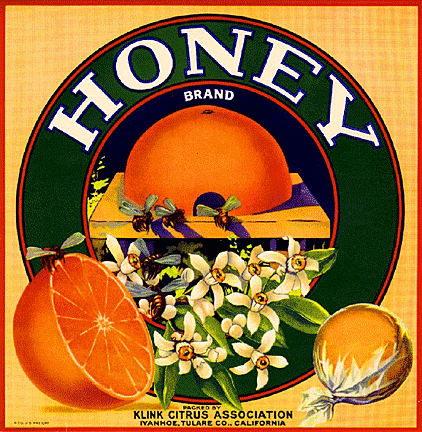 I’ve
fallen in love. No, not with another person, but with the colorful
labels on crates of oranges, grapefruits, and tangerines from Florida in
the first half of the 20th century. Over the last few years, I’ve
purchased prints of some of these labels which I framed to hang in my
kitchen. But I’d like to begin a real collection of them. What can you
tell me about the history of these labels? And what’s the best way to
begin my collection of actual labels? I’ve
fallen in love. No, not with another person, but with the colorful
labels on crates of oranges, grapefruits, and tangerines from Florida in
the first half of the 20th century. Over the last few years, I’ve
purchased prints of some of these labels which I framed to hang in my
kitchen. But I’d like to begin a real collection of them. What can you
tell me about the history of these labels? And what’s the best way to
begin my collection of actual labels?
Thanks,
Maria
__________________________________________________________
ANSWER:
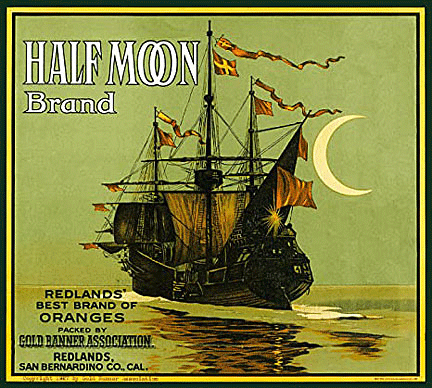 Vintage
citrus labels are one of the fun items to collect. They brighten up any
room with their glowing colors and cheery scenes of sunny Florida.
Collecting them isn’t that difficult and will send you on a hunt for
them for years to come. Vintage
citrus labels are one of the fun items to collect. They brighten up any
room with their glowing colors and cheery scenes of sunny Florida.
Collecting them isn’t that difficult and will send you on a hunt for
them for years to come.
Spanish explorers in the late 15th century brought small citrus trees to
Florida because lemons and limes were a part of the Spanish diet. When
Ponce de Leon explored Florida in 1513, he brought along citrus seeds,
planting them near what’s now St. Augustine. The seeds thrived in
Florida’s warm climate and sandy soil.
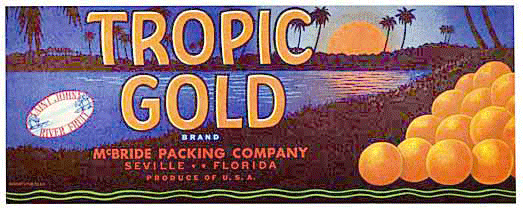
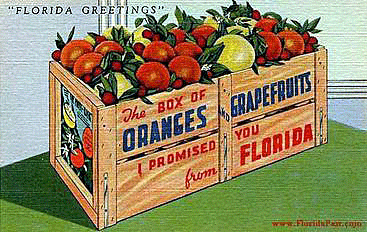 But
it wasn’t until three centuries later that homesteaders planted citrus
trees around their homesteads. Eventually, some began selling the fruit
locally or transporting it by coastal steamers which collected barrels
of fruit at various ports along Florida’s coasts. Once the railroads
began to expand, Florida fruit growers began to ship their produce to
emerging new markets throughout North America. But
it wasn’t until three centuries later that homesteaders planted citrus
trees around their homesteads. Eventually, some began selling the fruit
locally or transporting it by coastal steamers which collected barrels
of fruit at various ports along Florida’s coasts. Once the railroads
began to expand, Florida fruit growers began to ship their produce to
emerging new markets throughout North America.
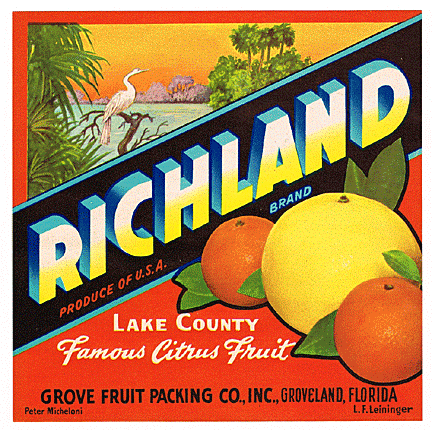 It
was the coming of the railroads that encouraged the creation of those
colorful, imaginative labels. Oranges had been grown for a long time in
Florida and even longer in California, but it wasn't until the
completion of railroad spur lines that it became possible to ship the
perishable citrus fruit nationwide. By 1875, growers began using It
was the coming of the railroads that encouraged the creation of those
colorful, imaginative labels. Oranges had been grown for a long time in
Florida and even longer in California, but it wasn't until the
completion of railroad spur lines that it became possible to ship the
perishable citrus fruit nationwide. By 1875, growers began using
90-pound wooden crates. Eager to capture the attention of wholesale
buyers in Eastern and Midwestern produce terminals, the growers began
pasting eye-catching paper labels to the ends of the crates.
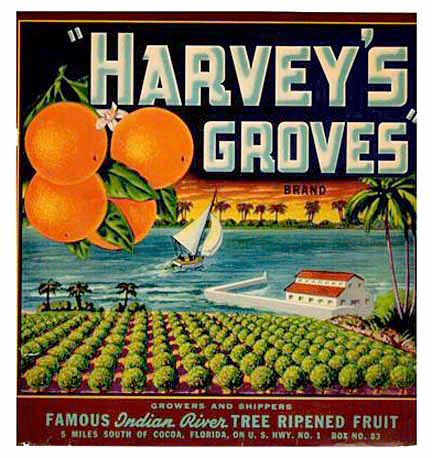 Originally,
the growers packed their oranges, grapefruits, and tangerines in wooden
crates branded or stenciled with their company identification. But once
color lithography came into common use, the fruit growers followed their
California competitors and began applying colorful labels to their
shipping crates. Originally,
the growers packed their oranges, grapefruits, and tangerines in wooden
crates branded or stenciled with their company identification. But once
color lithography came into common use, the fruit growers followed their
California competitors and began applying colorful labels to their
shipping crates.
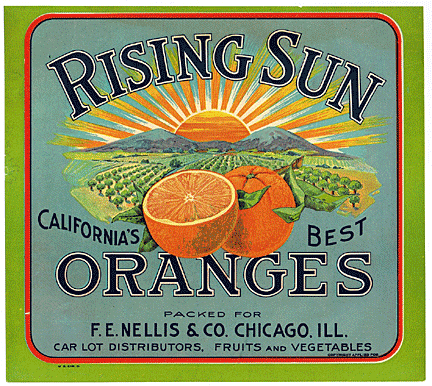 Old-time
produce markets were crowded places, so having labels with
eye-appealing, interesting artwork was a must. It was these same rich
colors and striking designs that grabbed the attention of citrus buyers Old-time
produce markets were crowded places, so having labels with
eye-appealing, interesting artwork was a must. It was these same rich
colors and striking designs that grabbed the attention of citrus buyers
Artists and lithographers designed labels to differentiate between
different growers. Beginning in 1904, they collaborated to help buyers
remember and identify their brands. The peak years for labels ran
between 1920 and 1950 but by World War II, growers began using cardboard
boxes instead of wooden crates which ended the use of the colorful
labels.
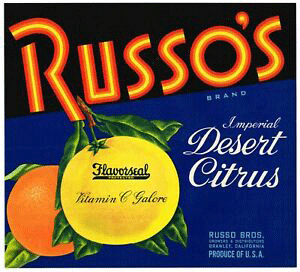 Label
art changed with the times. Fruit crate art can be divided into three
periods—Naturalism, from 1885 to 1920, Advertising, from 1920 to 1935,
and Commercial Art, from 1935 to 1955. In Florida, early labels seemed
designed to appeal especially to housewives, with pastel-tinted
illustrations depicting flowers or babies. Following these came label
illustrations showing Indians, planes, trains, hunting scenes, and
pretty women, all directed towards the all-male buyers at Northern
auctions. Label
art changed with the times. Fruit crate art can be divided into three
periods—Naturalism, from 1885 to 1920, Advertising, from 1920 to 1935,
and Commercial Art, from 1935 to 1955. In Florida, early labels seemed
designed to appeal especially to housewives, with pastel-tinted
illustrations depicting flowers or babies. Following these came label
illustrations showing Indians, planes, trains, hunting scenes, and
pretty women, all directed towards the all-male buyers at Northern
auctions.
In 1915, the general public became aware of vitamins and the health
benefits of the orange's Vitamin C content appeared in label art. Labels
from the Advertising era promoted the use of orange juice for health,
with names like "Juicy-o," "Juice King," and "Full o' Juice.”
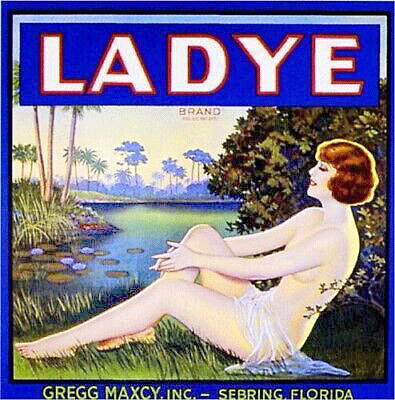 Artists
depicted a wide range of subjects, including beautiful women in
seductive poses such as the woman in a two-piece bathing suit sitting
seductively on the beach on the label for FLO Indian River brand.
Sebring’s LADYE brand portrayed a scantily dressed woman reclining by
the side of a pond. One grower even depicted his mistress on his label. Artists
depicted a wide range of subjects, including beautiful women in
seductive poses such as the woman in a two-piece bathing suit sitting
seductively on the beach on the label for FLO Indian River brand.
Sebring’s LADYE brand portrayed a scantily dressed woman reclining by
the side of a pond. One grower even depicted his mistress on his label.
The art work on the labels depicted the romance of Florida with scenic
views of orange groves, orange trees, and the oranges, themselves.
Sunsets and sailboats emphasized the fun potential of a Florida
vacation. The Golden Sunset brand portrayed palm trees and a warm,
glowing
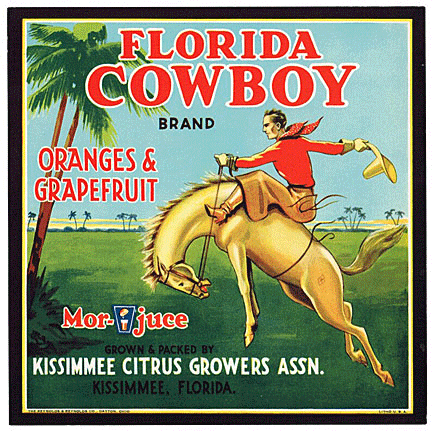 sunset
along with images of grapefruit and oranges while Groves brand showed a
azure blue sea with a sailboat and orange groves. The Dixie Delight
brand label depicted a couple in elegant evening attire ballroom
dancing. Both consumers and buyers got the message about the good life
in Florida, which helped to boost tourism. sunset
along with images of grapefruit and oranges while Groves brand showed a
azure blue sea with a sailboat and orange groves. The Dixie Delight
brand label depicted a couple in elegant evening attire ballroom
dancing. Both consumers and buyers got the message about the good life
in Florida, which helped to boost tourism.
Label artists also employed images of Florida flowers. The Gardenia
Brand adorned Jacksonville’s W.H. Clark Fruit label. The Kissimmee
Citrus Grower’s Association used the Florida Cowboy brand that showed a
cowboy riding a bucking bronco. Citrus growers and shipper’s children,
wives, and family members often appeared as subjects on their labels.
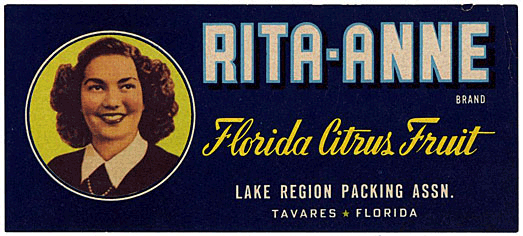
Artists also created labels depicting Florida wildlife, including birds,
alligators, and fish. Brooksville’s Blue Heron Brand portrayed the
majestic Florida bird, and the Jay Bird brand displayed a bluejay. The
Bull Frog brand used a plump bull frog on its label.
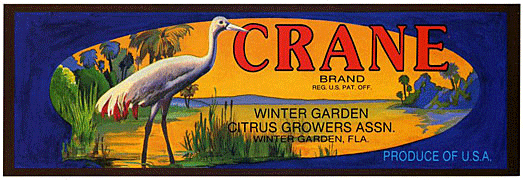
Citrus labels for Indian River’s Harvey’s Groves, for example, also
promoted fertile growing regions. The Polk O Dot Brand created a label
with a golden-haired child from the Polk County Citrus Exchange.
Native Americans were also well represented. The Highland Belle brand
label showed a Seminole princess while the Osceola brand depicted two
warriors paddling a canoe.
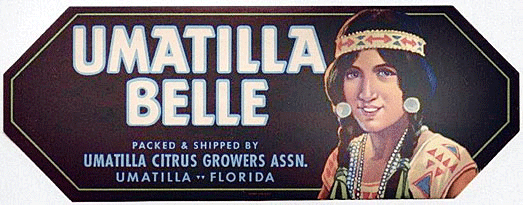
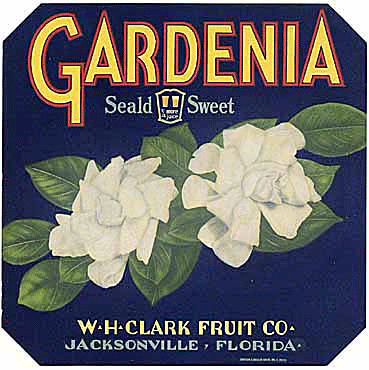 But
labels weren’t all show and beauty. They also served another purpose.
All prime fresh and Grade #1 fruit labels had a blue background, and all
Grade #2 or lesser labels had a red label. But
labels weren’t all show and beauty. They also served another purpose.
All prime fresh and Grade #1 fruit labels had a blue background, and all
Grade #2 or lesser labels had a red label.
Using the Internet, it’s relatively easy to find labels for sale. There
are also citrus label shows where a beginning collector can get an
overview of this unique collectible. Since there’s a wide range of
labels on the market, it’s very important for a collector to learn all
about them before buying any. In addition to original labels, there are
many prints on the market. While not original, these prints preserve the
unique art of the citrus label. Labels range in price anywhere from
$5-$10 for a basic print reproduction while an rare original label in
very good condition may sell for hundreds, or even thousands of dollars.
Essentially, citrus labels have become so popular because of the
nostalgia that takes collectors back to simpler days of Florida’s past.
<
Back to Readers Ask Archives Next
Article >
|
